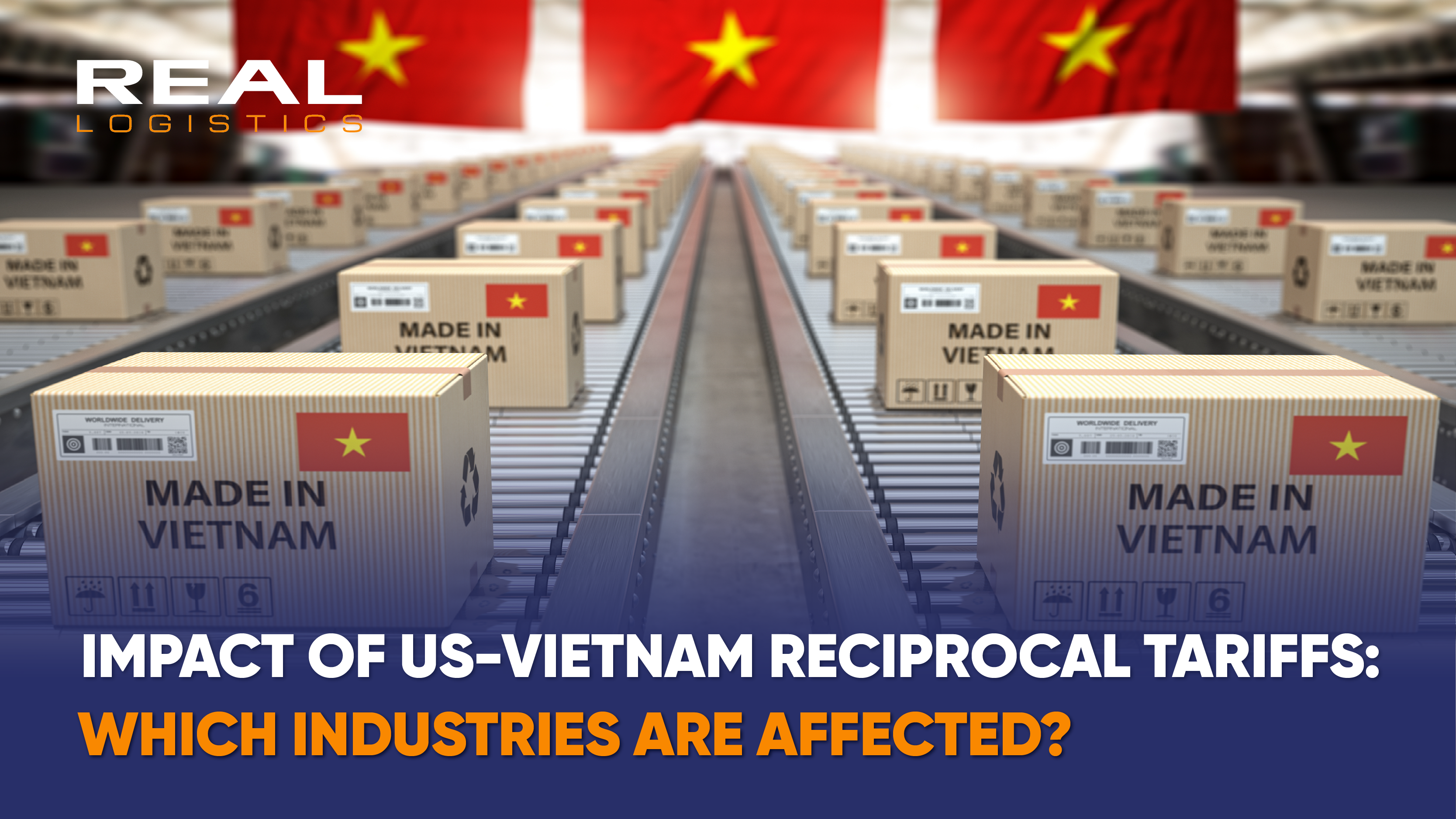Impact of US-Vietnam Reciprocal Tariffs: Which Industries Are Affected?

In the early hours of April 3, 2025 (Vietnam time), US President Donald Trump announced a new import tariff policy affecting 180 economies. Starting on April 5, 2025, a 10% base tariff will apply to all imports into the US. From April 9, 2025, higher tariffs will be imposed on over 60 countries with significant trade deficits with the US, including Vietnam, which will face a 46% tariff rate.
→ See the latest reciprocal tariffs table here.
1. Industries Heavily Affected
Vietnam is one of the largest exporters to the US, particularly in industries like electronics, machinery, textiles, footwear, wood, and seafood. The 46% reciprocal tariff will create significant challenges for these sectors.
| Product Group | % US Market Share of Each Group | Key Items | Prominent Enterprises |
| 19% Electronics | 32% | Laptops, electronic circuits, processors, data storage devices | Intel, HP, Dell, Amkor, Samsung, Victory Giant, Saigon Fabrication |
| 18% Machinery | 42% | Building tools, solar panels, machine controllers | Rockwell Automation, Techtronic, First Solar, Trina Solar, JA Solar |
| 13% Textiles | 43% | Sweaters, jeans, shirts, jackets, bags, backpacks | Crystal Group, Vinatex, May Sông Hồng, Dệt May Thành Công |
| 8% Mobile Phones & Components | 49% | Smartphones, phone parts | Samsung, Foxconn, Luxshare, Goertek, SMP Holdings |
| 8% Wood Products | 55% | Wooden furniture, accessories, children's toys, plywood | Phú Tài, Savimex, Kiến trúc AA, An Việt Phát, Eastwood, Kim Tín Group |
| 7% Footwear | 36% | Sports shoes, sneakers, leather shoes, boots | PouYuen, Vina Shoes, TBS Group, Biti’s, Thượng Đình |
| 3% Automotive | 22% | Complete cars, car parts, engines, trucks | Thaco, Honda, Vinfast, Ford |
| 2% Seafood | 18% | Basa fish, shrimp, squid | Minh Phú, Vĩnh Hoàn, Hùng Vương, An Giang, Stapimex, Sao Ta Foods |
| 22% Other Goods | 21% | Cashews, coffee, steel, aluminum | Long Sơn, Olam Vietnam, Intimex, Trung Nguyên, Đông Á Steel, Nam Kim |
Table: Export Share and Dependency on the US Market 2024
Source: GSO, Customs Department, VIS Rating
2. Detailed Impact Analysis
2.1. Textiles:
The US is the largest export market for Vietnamese textiles. High tariffs will increase product prices, reducing competitiveness against countries like Bangladesh and India. Companies may have to reduce labor or seek alternative markets.
2.2. Wood and Wood Products:
Exporting furniture, plywood, and cut timber to the US will face significant hurdles. This sector has previously been investigated for tax evasion, and the high tariffs will further challenge exporters.
2.3. Steel and Metals:
Vietnam's steel industry has previously faced anti-dumping tariffs from the US. With further tariffs, exports may drop sharply, affecting the steel industry.
2.4. Seafood (Shrimp, Basa Fish):
The US is the second-largest market for Vietnamese seafood. High tariffs on Basa fish and shrimp, due to price-subsidy accusations, will increase export costs, making it harder to retain market share in the US.
2.5. Electronics and Components:
Vietnam is a major manufacturing hub for Samsung, Intel, and LG. If tariffs are applied, these corporations may shift production to countries like India or Mexico to avoid tariffs.
2.6. Food Processing:
Exports of coffee, cashews, pepper, and spices will also be affected, with price hikes reducing competitiveness compared to Brazil and India.

3. Consequences for Businesses and Workers
- Job Losses: As orders decline, companies may reduce labor, especially in low-skilled positions.
- Income Reduction: The decrease in exports could lead to wage cuts and reduced benefits for workers.
- Cash Flow Difficulties: Export-dependent companies will face higher costs and reduced revenues.
- Impact on the Economy: Reduced income will lower consumer purchasing power, negatively impacting the domestic market.
4. Solutions for Vietnamese Businesses
In response to these challenges, Vietnamese businesses should:
- Diversify Export Markets: Explore new markets such as the EU, Japan, and South Korea.
- Restructure the Supply Chain: Collaborate with US businesses to manufacture in the US, minimizing tariff impact.
- Enhance Internal Strength: Improve product quality and reduce production costs to stay competitive.
The Vietnamese government is actively negotiating with the US to mitigate the impact of this reciprocal tariff policy. Vietnam has also reduced import tariffs on US goods and approved agreements allowing US companies to expand operations in Vietnam. The outcome of these negotiations will determine the extent and duration of the high tariff on Vietnamese exports to the US.
Real Logistics will continue to provide updates on the latest developments!
—————————————
Real Logistics Co.,Ltd
👉 Facebook: Real Logistics Co.,Ltd
☎️ Hotline: 028.3636.3888 | 0936.386.352
📩 Email: info@reallogistics.vn | han@reallogistics.vn
🏡 Address: 39 - 41 B4, An Loi Dong, Thu Duc, HCM City
51 Quan Nhan, Nhan Chinh, Thanh Xuan, Ha Noi City

